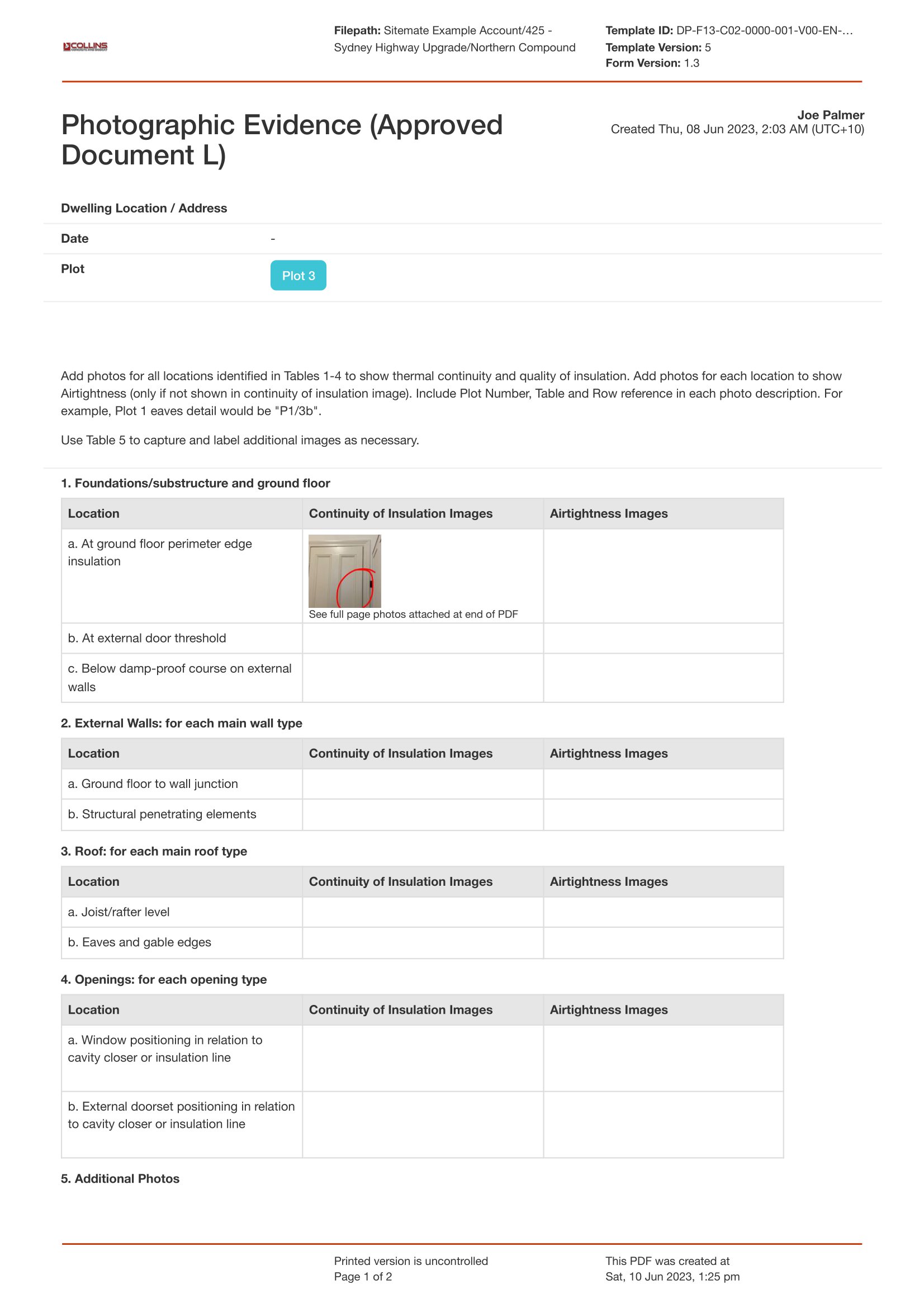Dashpivot article page – Part L Changes 2023

Part L Changes 2023
What do the Part L changes 2023 cover?
Part L of the UK Building Regulations covers the conservation of fuel and power aiming to reduce the UK's carbon footprint. The regulation requires both new and existing buildings to meet the UK's environmental goals in the coming years. Given that it concerns conservation, the regulation encourages the use of renewable energy and provides standards and requirements for insulation, heating, lighting and ventilation.
Part L is updated at regular intervals aligning with the targets set by the government to effectively lower energy bills and enhance the comfort and health of occupants. The religious changes are essential to vie with climate change. The UK has outlined broader goals for sustainability including the transition to net-zero emissions by 2050, hence the 2023 changes to Part L. This represents a crucial step towards improving the energy efficiency of buildings. The UK has also prepared The Future Homes Standards (FHS) which will be implemented in England by 2025, with Phase 1 as new homes to be zero-carbon ready, and by 2028, with Phase 2 as homes to be net-zero. This is the next iteration (Part O and F) of Part L and the government plans to publish FHS by 2024. The overall goal of Part L, and FHS in the future, is to reduce the carbon footprint emitted by buildings and the construction sector.
What are the key Part L changes for 2023?
-
New Energy Efficiency Requirements
Compared to the standards set out in 2013, new homes must produce less emissions at minimum 31% and non-domestic buildings at minimum 27%.
-
For New Homes
-
Part L 2023 has updated Fabric Energy Efficiency Standards (FEES) and insulation standards for walls, floors, floors, windows, and doors. The key focus for 2023 was to reduce thermal bridging, where walls meet floors, walls meet roots, etc. If not taken into account, thermal bridging causes major heat loss, condensation, and even cold spots. To meet the efficiency targets, that means thicker and high-quality insulation is needed for walls, roofs, and floors and should be implemented continuously across all the building elements without any room for gaps. In addition to that, the new standards also recommend using materials that have a higher thermal mass to achieve consistent indoor temperature.
-
Instead of using conventional gas and oil boilers, it is highly encouraged to use low-carbon technologies and pave the way for their future installment or what’s called “future-proofing”. New homes are required to be designed to accommodate plans for “future-proofing” and ease of installation of heat pumps and other renewable heating systems. In the new regulation, the use of gas and oil boilers are being phased out and they are also non-compliant in the Future Home Standards starting in 2025.
-
New homes are also expected to use solar photovoltaic (PV) panels or solar thermal systems for electricity generation and also use them to power the suggested renewable heating systems (such as heat pumps).
-
-
For Non-Domestic buildings
-
Non-domestic buildings such as commercial, industrial, and public buildings like schools, offices, hospitals, retail spaces, and warehouses have stricter carbon emissions goals. The building fabric standards are also updated to achieve better thermal insulations and air tightness. Similarly with new homes, thermal bridging should be minimized as it causes major heat loss, condensation, and even cold spots
-
Non-domestic buildings are encouraged to use low-carbon heating systems and to stop using gas and oil boilers, similarly with new homes. The regulation recommends the use of heat pumps, biomass boilers, and Combined Heat and Power (CHP) systems or otherwise known as cogeneration and to completely remove the traditional methods of heating. CHP systems generate electricity or mechanical power and usable heating and/or cooling energy coming from a single source of energy. Aside from reducing energy costs, emissions are also reduced in CHP systems. They reuse the heat that is wasted from hot exhaust gasses into heating/cooling systems.
-
The HVAC systems being used in non-domestic buildings should integrate with the mentioned low-carbon heating systems, like heat pumps. Ventilation requirements are also updated to encourage the use of a Mechanical Ventilation with Heat Recovery (MVHR) that recovers and reuses waste heat from ventilation. MHVR is a ventilation system that uses a heat exchanger to recover the heat extracted from the damp air, and transfers it into the new fresh air coming from outside. One of the major benefits in integrating MVHR is it provides oxygen and removes carbon dioxide, making it easier for the persons inside the building to breathe.
-
In lighting and electrical systems, the updated regulation mandates energy-efficiency lighting, meaning using LED lighting systems. LED lighting systems use less energy compared to the usual incandescent bulbs, more durable, eco-friendly, and they mimic natural lighting. Using daylight-responsive and smart controls, and daylight harvesting systems are also recommended to offset the amount of electric lighting required in a space.
-
Non-domestic buildings are required to use control systems to monitor the energy usage. Building Energy Management Systems (BEMS) also allow the adjustments of heating, cooling, lighting, and ventilation systems depending on various conditions. BEMS can be used to maintain comfortable temperatures inside a space and it makes it easier to comply and adjust with new regulations being implemented. Data is also generated real-time and you can export them to monitor energy trends and for audits or reports. Installing monitoring systems is one of the ways to “future-proof” spaces.
-
-
Existing Buildings
-
If construction is to be undertaken in existing buildings, such as renovations and extensions, the new and updated standards and regulations should be followed. In any part of the building that needs significant updates, they must comply with the improved energy efficiency standards and the building elements such as walls, floors, and roofs are required to meet the new Fabric Energy Efficiency Standards (FEES) indicated.
-
For any replacement of building elements such as windows and doors, they must meet the new standards set in the 2023 Part L upgrade. The replacement windows, doors, and other similar are mandated to meet the new U-values and efficiency standards indicated.
-
Switching to low-carbon heating systems are also recommended for existing buildings upon renovations, building upgrades, or whenever possible. It should be ensured that these systems are installed with “future-proofing” in mind.
-
Switching to renewable energy is also highly encouraged for existing buildings, such as integrating solar photovoltaic (PV) panels to generate electricity and solar thermal systems for water heating.
-
-
New Compliance Metrics
-
Primary Energy Rate (PER) (in KW-h)
-
This is a new metric being introduced in Part L 2023 and it measures the energy being used by a building that considers the fabric and fuel. PER is a new metric in the Part L 2023 updates but it has long been used in Wales since 2014. This helps compute the amount of energy that is required to provide heating and hot water in a building, also including energy used by cooling systems, ventilation and lighting.
-
Target CO2 Emission Rate (TER)
The TER is indicated in the new Part L 2023 regulation and represents the maximum allowable carbon emissions from a building. Developers should ensure that their Building CO2 Emissions Rate (BER) calculated should not exceed the TER to comply with the new regulation. BER < TER.
-
Energy Use Intensity (EUI)
This is the measurement of the building’s total energy consumption per square meter.
-
Preparing for the Future Homes Standard (2025)
As mentioned, the updates in Part L 2023 is a stepping stone for the implementation of Future Homes Standard in 2024 where new homes are required to produce less carbon emissions by 75-80% in order to achieve the net-zero carbon emissions goal of the UK by 2050.
How to stay compliant with the Part L changes beyond 2023?
Staying compliant with the 2023 Part L changes will help in the UK’s ambitious goal to net-zero carbon emissions by 2050 be achievable. The regulations from the 2013 Part L are no longer followed as the changes for 2023 formally came into effect on June 15, 2022.
The UK government provided a one-year grace period for developers to implement the adjustments and to finalize projects that began before the Part L 2023 updates, which ended on June 15, 2023. From then on, building managers, owners, and developers are required to be fully compliant with the Part L 2023 updates to contribute to a decarbonised economy.
Stay compliant with the Part L changes 2023 regulation by following this comprehensive Part L Regulation and Compliance Guide quick summary:
-
Design with efficiency in mind. Take note that using high-quality insulation, air tightness, and efficient building materials are key to reducing heat loss.
-
Install low-carbon heating systems such as heat pumps, biomass boilers, CHP systems, and integrate renewable energy systems such as solar photovoltaic (PV) or thermal systems. Conduct regular maintenance and inspection and keep records to ensure your systems are still functional. Create general reports to ensure all systems are accountable for, and if repair or replacement are needed, they can be done as swiftly as possible.
-
Conduct regular permeability tests to test air tightness and keep a record for each and every time tests are conducted. It is essential to keep records for reports, and to ensure the buildings are still compliant to the new standards.
-
Test for insulation to ensure that the insulation meets the updated U-value standards and keep records for every time tests are conducted. Stay on track with your test results to comply with regulations and avoid expensive replacements in the future.
-
Use energy-efficient lighting and smart controls
-
Use Building Energy Management Systems (BEMS) to monitor energy usage.
Developers, building managers, inspectors, and anyone involved need to record energy efficiencies, regular inspections, maintenance checks, tests, and document how your construction stages are meeting your energy efficient designs by using a Part L compliance document, air permeability test documents, heat pump equipment forms, boiler maintenance forms, solar PV forms, accredited construction documents, and many more.
In the 2023 update for Part L, builders and developers are required to take photographs of any installation for compliance. These photos confirm that the design details have been followed and these are strictly implemented in the Part L 2023 regulation. Photos are also required to be geotagged to verify the correct location of the construction site. Use a Part L Photographic Evidence document to comply with the new regulations and use that as a form of proof that the required measures have been implemented during construction or renovation.
Why do you need Photographic Evidence?
Use a digital Part L Photographic Evidence template to keep track of your development stages and that they match your designs.
-
Attach your photos directly to progress reports with timestamps, geotagging and markup to highlight important information and/or changes.
-
Compliance is a breeze with the standardized template, with digital signoff and a full audit trail.
-
Create or customize the pre-built template so you always capture all the information you need, every time.
Use other digitized forms to document anything related to Part L to ensure you’re regularly complying to the standards.
-
Part L Inspection Form
-
Part L Building Compliance Form
-
Part L As Built Document
-
Accredited Construction Details Document
-
Solar Panel Maintenance Checklist
-
Building Maintenance Checklist

Use a digital Part L Photographic Evidence template for your compliance
How to Integrate your Part L Processes?
Keeping compliant of your Part L Building Regulations can be quite difficult with lots of repetitive tasks to track.
A Part L Photographic Evidence app can help keep track of your Part L stages to reduce double handling of reports, and missing periodic updates.
Create automated workflows to request new reports, complete reports and then signoff, so nothing is missed or waiting to be completed.
Distribute your digital template to your team to complete in the field via mobile or tablet, so it's easy to take photos and attach them directly to their report.

Inspection and Test Plan (ITP) template
No one plans to fail, they fail to plan. Ensure your projects are a success with this ITP.

Non-Conformance Report template
Document those painful non conformances with this powerful template.

Construction Punch List template
Punch your way through those punch lists with this powerful template.


